You might already know that a reading conference is one-on-one reading instruction. But how do you conduct a reading conference? And are they really worth the time they take?
Every school day is packed, and it seems as if there’s never enough time to “fit it all in.” I feel like reading conferences are one of the first things that get eliminated from the literacy block!
BUT they are so valuable! In today’s post, I’ll share with you WHY reading conferences are important and explain HOW to conduct them!
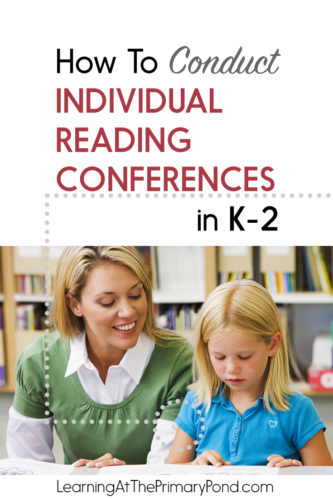
Why one-on-one reading conferences?
When I first began teaching, I didn’t make time for one-on-one reading conferences.
I taught guided reading groups and gave my students as much individual attention as I could. But I’d set up my literacy block so that students read independently as a center, so I was occupied teaching guided reading during that time. With this setup, I really couldn’t conduct reading conferences.
However, I quickly realized how important it was for me to check in with students while they read independently. Conducting reading conferences allows me to:
- See what books students are choosing to read independently (and help them adjust the level, if necessary)
- Determine if students are actually applying what they are learning during other parts of the literacy block (it makes no sense to teach, teach, and teach and then not see if they are applying the skills to where it really matters—independent reading!)
- Spend precious one-on-one time with my students (this helps build our relationship and also allows me to provide super-targeted, relevant instruction to each reader)
If you’re still not convinced, consider this metaphor:
Let’s say that your car has an engine problem. You take the car into the shop, and the mechanics do their best to fix it. But they don’t test-drive the car to see if the problem is solved. You pick up the car, assuming that the problem is solved, but you drive half a block and it breaks down again! ??♀️
In this metaphor, your reading instruction = the mechanics trying to fix the problem. Reading conferences = test-driving the car.
You wouldn’t want your mechanic to try to fix the problem and simply hope for the best. Similarly, we shouldn’t teach, teach, teach and hope for the best without checking to see if our students are actually using what they learn when they read independently!
Now, I always set aside daily time for students to read independently while I conduct as many reading conferences as time allows. I may not get through very many conferences in one day, but I’m at least making some time for this super-important practice.
What “should” a reading conference look like?
I put “should” in quotation marks above because there’s no one right way to conduct conferences!
Generally speaking, a reading conference is about 5 minutes long, involves the teacher and one student, and is designed to target students’ individual needs. In a reading conference, the basis for the discussion / instruction is a book that the CHILD has selected to read.
I don’t have a set number of conferences that I conduct per day or week (although I do try to see all of my students once every 2 weeks). The number of conferences that you conduct each day will depend on a) your daily schedule and b) the frequency with which you see students in guided reading / small groups. (If you only see students in small groups about once a week, then you will want to plan for more individual reading conferences than if, say, you see students 3-4 times per week for guided reading.)
I tend to teach 3 different types of reading conferences: standard, check-back, and extended conferences. In the next sections, I’ll explain what each one of these conferences looks like.
Standard Conferences
In a “standard” conference, I follow the observe-compliment-teach routine. This is not something I made up; many teachers use this method, and I believe I first learned about it in Jennifer Serravallo and Gravity Goldberg’s 2007 book Conferring with Readers. In an observe-compliment-teach conference, I see how the student is doing, provide a compliment about something she is doing well, and teach or review one strategy to help her move forward.
For me, a successful conference begins before I ever sit down with the reader. I have to have, in my mind, some general ideas about what I might want to work on during the conference. Otherwise, one of two things might happen:
- I go blank and am not sure what to teach during the final part of the conference
- I notice something that I could teach, and I teach the strategy—but it’s not a “high priority” strategy (meaning, it’s not related to our current reading workshop unit or an important skill for the student to master at his/her current reading level)
To avoid this, I always try to have these two things with me during ANY conference:
- A list of goals for our current reading unit
- A list of strategies that are relevant to the student’s current reading level (since I have readers at many levels, I have many checklists with me and simply turn to the correct one for each student)
Here are examples of both (the “class checklist” is from a second grade reading unit and has one additional page, not shown; the Level H rubric is an example of a reading level specific strategy list):
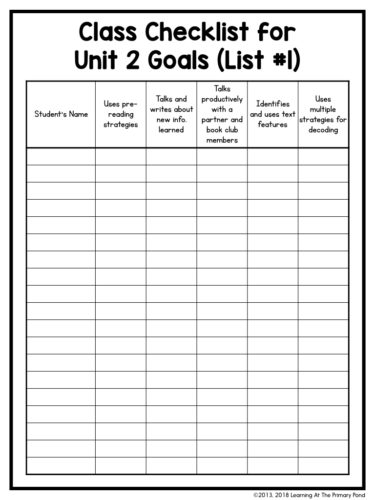
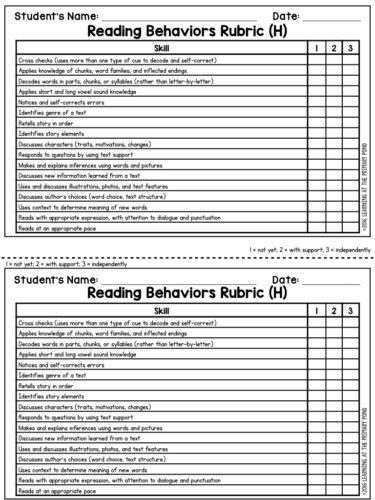
Being prepared for a conference is essential and helps me get the most “bang for my buck!” When it’s time to conduct the conference itself, here’s what that looks like:
Observe
- I check in to see how this reader is doing. I want to find at least one thing to compliment him/her on, and one thing to teach to move the reader forward.
- I usually do one of the following things during the observation component: ask the reader what strategy he/she is working on, ask a focused question to help me find out something specific (“Why did you choose this book?” or “What do you like about this book?”), ask the reader to describe what is happening in the text (comprehension check), or ask the reader to read a section of the text out loud to me.
- I try to jot down at least one thing I see the student doing well and one area for improvement.
Compliment
- I tell the reader what I noticed her doing, using very specific language. (Example: “I saw that you covered up the end of that word with your finger. You read the base word, uncovered the ending, and read both parts together. That was a great strategy for figuring out a longer word!”)
- I encourage her to keep doing it!
Teach
- I teach the reader one new strategy that I believe could help move her forward, OR I review something that we have worked on in the past.
- This teaching point is usually related to one of my goals lists that I mentioned before – the unit-specific checklist, or the reading level specific checklist).
- To demonstrate the strategy, I choose a different word or section in the text she is reading OR I use a text that I brought to the conference for modeling purposes (you can read a little more about that strategy HERE).
- If possible, I ask the student to demonstrate the strategy right there and then (this can usually be done easily with decoding or fluency strategies), OR to write on a sticky note the next time she uses the strategy (better for comprehension or vocabulary strategies).
- I provide a visual reminder to help the student remember to use the strategy (I like to use these strategy cards from my reading workshop toolkits, shown below)
- I thank the reader for conferring with me and wrap up the conference!
All of this happens in about 5 minutes, which can make timing tricky!! Use a timer if you’re having trouble keeping your conferences brief. 🙂
Check-Back Conferences
A check-back conference is slightly different and does not follow this observe-compliment-teach routine. In a check-back conference, I’m touching base with a student to see if she has been using a strategy I taught previously.
The structure of this type of conference is a little “looser.” I might begin by:
- Asking the child to read aloud from his book
- Inquiring directly about the strategy: “Can you show me an example in this book or another one where you <made a prediction / insert your own strategy here>?”
Once I’ve determined whether or not the child is using the strategy, I then:
- Praise the child for using it (if applicable)
- Re-teach the strategy in a different way (if necessary)
- Provide a visual reminder to use the strategy (if I haven’t already)
- Encourage the child to continue using the strategy
In my own notes, I record my observations about if/how the child is using the strategy (or not using it yet).
Extended Conferences
An extended conference is….just what it sounds like. 🙂 A longer conference!
I rarely use extended conferences. But if I’ve noticed that a child is REALLY struggling with one aspect of reading, and guided reading / regular conferences aren’t helping, I know that I have to devote a little more time to helping him/her.
In an extended conference, I basically eliminate the “Observe” portion of the “Observe-Compliment-Teach” routine. (It’s unnecessary; I already know what I want to work on!)
I begin by giving the child a compliment about his / her reading. Then, I spend 5-10 minutes working with the child on the “trouble spot.” I incorporate modeling, guided practice, and then encourage the child to continue using the strategy independently.
When I conduct an extended conference, I usually follow it up with a “check-back” conference a few days later. Since I devoted extra time to that student, I want to make sure that he/she is following through with the strategy!
More Help with Reading Workshop
For more help with reading workshop, take a peek at my new shared reading units for Kinder, 1st, or 2nd grade. You can learn about them HERE!
Happy teaching!

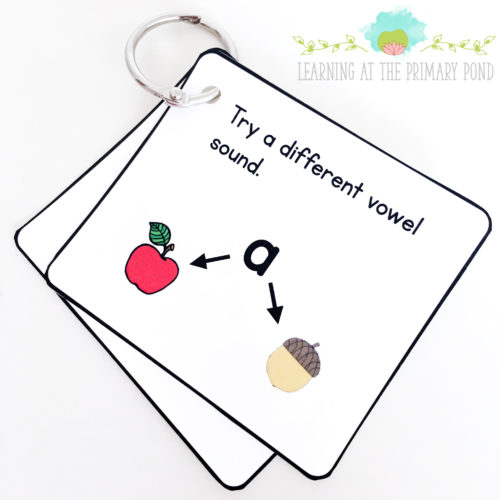
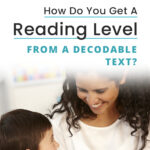


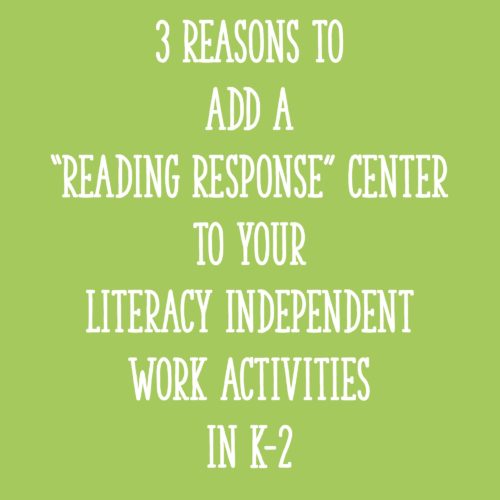








Hi Alison!
Love your posts! Do you sell your leveled reading check lists? Do the behaviors listed come from Fountas & Pinnell’s Literacy Continuum?
Thanks for sharing your knowledge!
Thank you so much!!
I do have them, here: https://www.teacherspayteachers.com/Store/Learning-At-The-Primary-Pond-Alison/Category/Guided-Reading-Individual-Levels-317852
They are mostly aligned with the Continuum, yes!
Alison
Where can I find the reading level specific strategy lists that you referenced during the standard conferences?
Hey! You can check those out here – let me know if you have any questions! 🙂
Alison